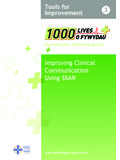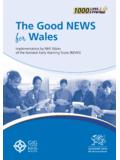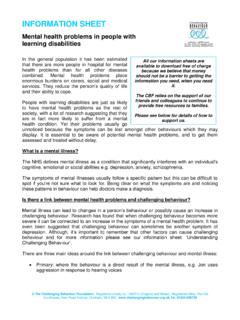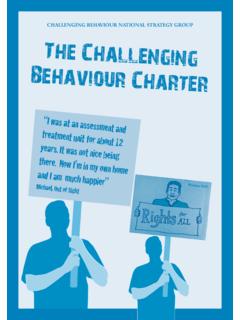Transcription of Improving general hospital care of patients who …
1 Improving general hospital care of patients who have a learning disability Improving general hospital care of patients who have a learning disabilityAcknowledgementsThis improvement guide has been written by Barbara author would like to thank the members of the learning disability Nursing Network, and particularly Christopher Griffiths, for their contributions to this guide. The guide has been published by 1000 Lives Improvement, which is part of Public Health Wales and supports organisations and individuals to deliver improved health, healthcare outcomes and user experience in NHS Wales. Date of publicationImproving general hospital care of patients who have a learning disability was first published in 2014. The latest version will be available on the 1000 Lives Improvement website, purpose of this guideThis improvement guide has been produced to enable healthcare organisations and their teams to successfully implement a series of interventions to improve the safety and quality of care that their patients is recommended this guide is read in conjunction with the following: How to Improve - The guide for reliable and sustained improvement The 1000 Lives Improvement Quality Improvement Guide learning to use Stories for Improvement These are available from 1000 Lives 1000 Lives Improvement1000 Lives Improvement wants to support NHS Wales staff and contractors in the work they are doing, to improve care and services.
2 The service offers help in a number of ways National programmes addressing issues at a strategic level. Bespoke improvement projects targeting specific issues identified by organisations. Improvement support services designed to equip and enable NHS Wales staff to make improvements, including publications and resources, events, advice and general hospital care of patients who have a learning disabilityContents51. Introduction 2. The general health of people with learning disabilities Why do people with learning disabilities find it harder to access effective healthcare services Risks and challenges Reasonable adjustments3. general hospital care of patients who have a learning disability care bundle and Driver Diagram The Model for Improvement4.
3 Drivers and interventions Driver 1: Effective Communication with patients , carers, family members and clinicians Driver 2: Provide person-centred care Driver 3: Effective review and discharge planning5. Appendices Appendix A Example of a hospital Passport Appendix B Examples of Educational Posters Appendix C Glossary of Terms Appendix D Contacts References4591432 Improving general hospital care of patients who have a learning The acid test of a national health service is not whether it works for people who are generally healthy but whether it benefits those with the shortest life expectancy, the greatest problems accessing services and the biggest risk that poor health will stop them taking part in society. ( disability Rights Commission, 2006) The Confidential Inquiry s findings show that people with learning disabilities continue to have poor experience and outcomes compared to people without learning disabilities.
4 (Department of Health, 2013)1. Introduction Definitions and characteristics of learning disabilities First and foremost, people with learning disabilities are people . They are unique individuals with their own likes and dislikes, history and opinions and they have the same rights as anyone else (GAIN, June 2010). learning disabilities is an umbrella term for persons who have varying degrees of Impairment of intellectual and social functioning . learning disabilities affect about million people in the UK and are common, lifelong conditions which are neither illness nor disease. In Wales there are some 11,000 adults with learning disabilities who are known to social services and in receipt of services. There are estimated to be at least a further 40,000 adults with milder learning disabilities who are not in receipt of services (Welsh Government, 2007).
5 learning disability commonly refers to a history of developmental delay, a delay in or failure to acquire a level of adaptive behaviour and/or social functioning expected for a certain age, and evidence of significant intellectual impairment. learning disability is nearly always present from birth, although some people do acquire a learning disability through trauma or infection. For them, their condition is the norm and it will always be disability is a lifelong condition, although with appropriate support many people can acquire practical and social skills, even if this may take them longer than usual. However, some people with a learning disability may also have other physical and emotional conditions and this may lead to the person having more than one diagnosis.
6 The nature of people s learning disability varies widely and will affect the kind of support that they may require. Many people with a learning disability will have a significantly reduced ability to cope independently in a variety of situations (including health services), to understand new or complex information, to learn new skills (whether practical things like tying shoelaces, or social skills such as holding a conversation or self- care ), and they may have difficulty with generalising any learning to new situations. Some people with learning disability may not have any effective verbal general hospital care of patients who have a learning disabilitycommunication and need to find other ways of communicating with those around them. Some need help with everyday things like getting dressed or making a cup of tea, whilst others will live quite independently with minimal is expected that by 2020 the number of people with a learning disability in the UK will have grown by over 10 per cent as well as a growth in the complexities of learning disabilities (Michael, 2008).
7 This is due to people with learning disabilities living longer and also due to young people with complex disabilities surviving into The general health of people with learning disabilities people with learning disabilities have very diverse personalities and characteristics. Like the rest of the population, they acquire and develop other conditions and diseases which need to be treated. However, some conditions may occur more frequently. Research evidence consistently suggests that people with a learning disability are at greater risk of physical and mental ill health than the general population. In 1998, Hollins et al reported that people with a learning disability are 58 times more likely to die aged under 50 than other people , and four times as many people with a learning disability die of preventable causes than do people in the general population.
8 More recently, the Confidential Inquiry into Premature Deaths of people with learning Disabilities (CIPOLD) Final Report (Heslop et al, 2013) found that, on average, men with learning disabilities die 13 years younger than the general male population and women with learning disabilities die 20 years younger than the general population. Many of these deaths are considered avoidable and/or premature. Michael (2008) reported that the general standard of health of people with learning disabilities is lower than for the general population. They have a greater risk of poorer health because they experience greater variety, complexity and range of health problems compared with the general population. Reviewing studies related to the health of people with learning disabilities and the inequalities in health that they experience, Emerson et al (2012) note the following: The prevalence rates of epilepsy are reported as being 20 per cent in the learning disability population, compared to less that one per cent in the general population, and seizures may be both multiple and treatment resistant.
9 Dementia is said to occur in 22 per cent of adults with learning disabilities aged over 65 compared with a prevalence rate of 6 per cent for the general population. It may also occur earlier in certain groups, Down s syndrome, where people in their 30s and 40s may display symptoms. Improving general hospital care of patients who have a learning people with Down s syndrome are also at a specific risk of hypothyroidism with studies reporting prevalence rates of 9 19 per cent. Approximately 40 per cent of people with learning disabilities have some degree of hearing loss. Estimates of visual impairment vary widely and are given as being 8 200 times more likely in people with learning disabilities than the general population. Research is limited but there is some suggestion that people with learning disabilities may be at higher risk of osteoporosis than the general population.
10 One in three adults with learning disabilities and four out of five people with Down s syndrome have unhealthy teeth and with learning disabilities have a higher risk of coronary heart disease (second most common cause of death) and higher rates (roughly double) of gastrointestinal cancers, such as oesophageal, stomach and gall-bladder, and stomach disorders, and are more prone to developing diabetes than the general population. Respiratory disease is the main cause of death in people with learning disabilities. They are at risk of respiratory tract infections caused by aspiration or reflux if they have swallowing difficulties, and they are less likely to be immunised against infections and hence are three times more likely to die from respiratory disease than are the general population (RCN, 2006).















